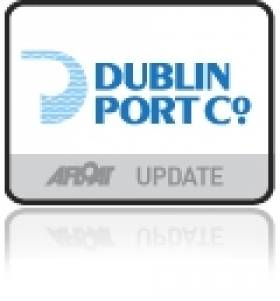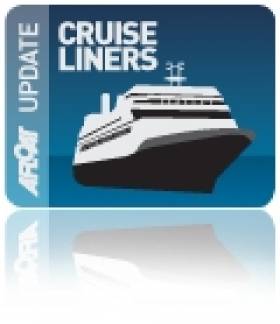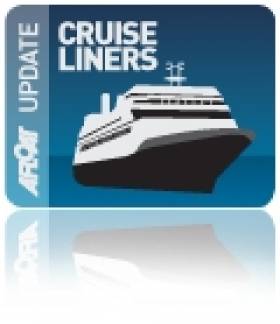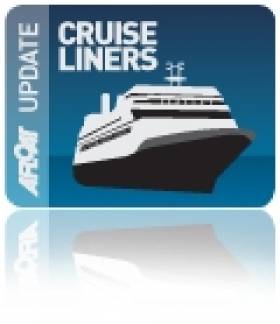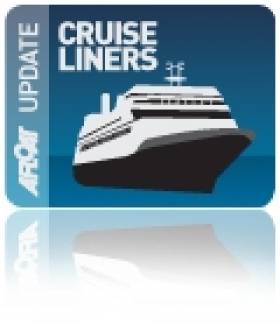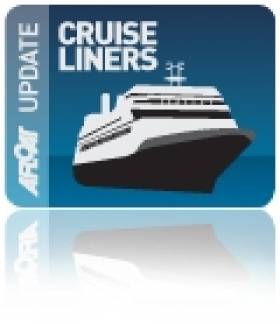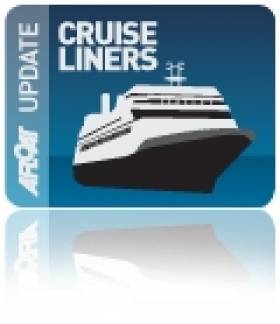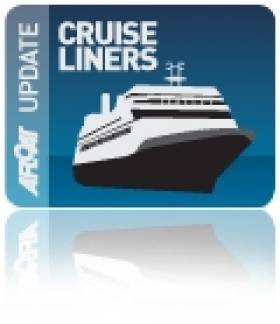Displaying items by tag: Cruise liner
Cruise Liner Berth Boost as €200m Alexandra Basin Project Launched By Dublin Port Company
#dublinport – Dublin Port Company has lodged a planning application with An Bord Pleanála for its Alexandra Basin Redevelopment (ABR) Project. The application is being made under the Planning and Development (Strategic Infrastructure) Act and follows a twelve month consultation with industry, government, customer and community stakeholders. Local information centres will be open over the coming weeks with details of the proposal plans on view.
The ABR Project involves an application to An Bord Pleanála for permission for phased redevelopment work on some of Dublin Port's existing infrastructure. Some 42% of Dublin Port's berths (3km of the port's 7km) will be lengthened and deepened and the 10km channel from Dublin Bay to the East Link Bridge will be deepened. It is the first large scale project under Dublin Port Company's Masterplan 2012-2040, a framework for the future development of Dublin Port with reference to economic and trade developments set in the context of EU, national, regional and local development plan policies.
The ABR Project will cost an estimated €200 million and Dublin Port Company has the financial resources to fund the project. The engineering works will take place on a phased basis and are expected to take five years to complete, supporting some 200 construction related jobs in the process. It is further estimated that the growth in volumes which the project will facilitate will result in 320 jobs being created annually between 2012 and 2040.
Commenting on the application for Dublin Port Company's Alexandra Basin Redevelopment (ABR) Project, Eamonn O'Reilly, Chief Executive of Dublin Port Company said, "Dublin Port Company's ABR Project will give us the infrastructure, capacity and versatility needed to futureproof Dublin Port, catering for larger sized vessels and increased trade volumes as Ireland returns to economic growth. Dublin Port Company is committed to carrying out this project within our current footprint, re-developing and utilising existing port lands in the most efficient way possible, while financing the project from our own resources.
"We have engaged with Government, business and industry stakeholders, customers and local communities over the past year to help shape today's planning application. The public can view the proposal in detail, meet members of the project team at public information days from 25th – 27th March and learn about all aspects of the project over the coming weeks", he added.
Submissions or observations on the application may be made to An Bord Pleanála at 64 Marlborough Street, Dublin 1, by 7th May 2014.
The project comprises engineering redevelopment works in the Alexandra Basin and in the Berth 52/53 Basin. Some of the proposed development works will include*:
Proposed Purpose
ALEXANDRA BASIN
Deepening and reconfiguration of quay walls at North Wall Quay Extension (937m total length), including the relocation of the North Wall lighthouse.
Extension of Alexandra Quay (130m).
Rebuilding of existing, life expired quay walls in the remainder of the Alexandra Basin West (aggregate length of 1,200m).
New 273m long Ro-Ro jetty with Ro-Ro berths on either side.
To increase Dublin Port's berth capacities using the port's existing footprint so as to accommodate larger freight and passenger ships at multi-purpose berths.
The multi-purpose berths will cater for a range of uses, including freight and cruise.
BERTHS 52/53
Construction of a new 300m river berth at Berth 52/53 and two new mooring jetties.
To provide the port with two river berths for the largest future Ro-Ro ships.
DEEPENING THE PORT
Dredging of the Liffey Channel and approach to the port to a depth of -10m (Chart Datum) from east of the East Link Bridge to the Dublin Bay Buoy, a distance of about 10km in total.
To provide a deeper channel for larger vessels including, ferry and cruise ships.
Port of Cork Signs Up to Atlantic Alliance Cruise Ship Destination Project
#atlanticalliance – The ATLANTIC ALLIANCE is a marketing project of 18 ports along Europe's West coast between Hamburg and Lisbon, including Britain and now an Irish port. The project highlights to cruise companies that there is in Europe an attractive alternative to the Mediterranean and Baltic. The multifaceted character and diversity of the Atlantic Alliance members offer a versatile portfolio of cruise content for the cruise companies.
Hamburg, 23rd of September 2013. The Atlantic Alliance is delighted to welcome the Port of Cork to the association. With the addition of Cork, the first Irish port to join the Alliance, the marketing project now covers in total eight countries. "The Alliance is proud to extend the region by aiming towards establishing a Euro-Atlantic destination on its own", says Nadine Palatz, Manager Atlantic Alliance.
Cork represents a key strategic member in terms of the implementation of the new EU sulphur directive which is due to come into effect in 2015. Within a North Sea context, this gives Cork an advantage for future cruise calls.
Port of Cork is on the South Coast of Ireland and makes the Euro-Atlantic picture more complete, as marketed by the Atlantic Alliance.
"Cork is home to some of Ireland's most famous tourist attractions such as Blarney Castle and Jameson Whiskey Distillery and also serves as a convenient gateway for visiting the many picturesque towns and sights of West Cork, Waterford and Killarney. We are delighted to be joining Atlantic Alliance in promoting Cork as a 'must see' destination on Ireland's south coast" commented Captain Michael McCarthy, Commercial Manager, Port of Cork Company.
The Port of Cork is home to Ireland's only dedicated cruise berth in Cobh and will have welcomed a total of 61 cruise vessels carrying over 100,000 passengers and crew by the end of the 2013 season. This is up from 35 calls in 2005 and the Port of Cork has ambitions to grow the number of cruise calls to 80 over the next five years and to increase turn-around calls and overnight stays.
All cruise vessels that call to Cork are given a very special welcome courtesy of Cork Cruise, providing tourist representatives who go on board each vessel, a display of traditional Irish dancing for passengers and a fond farewell on the quayside with a performance by a local brass band. These efforts do not go unnoticed by the passengers and the cruise lines and in 2011 the Port of Cork was awarded two Cruise Insight Awards for 'Best Shore Side Welcome' and 'Best Tour Guides'.
Expedition Ship Arrives, Another Cruise Call for Dun Laoghaire
#cruiseliner – The cruise ship Corinthian is an early cruise caller to Dun Laoghaire harbour this morning, another arrival to the South Dublin Harbour, just 12 hours after the departure of the prestigious Queen Elizabeth.
This private yacht-like cruise ship (a sister of the Sea Explorer) was escorted in to the harbour by the Dublin Port Pilot Vessel, Dodder.
The 1990–built passenger vessel has berthed inside the harbour walls, at the East Pier, shortly after 7am, unlike yesterday's visit by MS Queen Elizabeth where the 294–metre ship anchored approximately one kilometre to the south of the harbour in Scotsman's Bay.
From the Adventure life website, Corinthian is described as as a 'Luxury Expedition Ship' and its itineraries include trips to Antarctica, Patagonia and other exotic locations. Check it out here.
The ship accommodates only 100 guests in 50 suites, each of which affords sea views.
At 88–metres in length, the Corinthian, on overnight passage from Oban in Scotland, is a much smaller ship so her alongside harbour berth at the town band–stand dispenses with the need for tendering of passengers ashore.
In the last week of July, issues concerning tendering permits led to the relocation of the MV Cruise Ship Oriana from Dun Laoghaire to nearby Dublin Port, the main cruise–liner destination in the Capital.
Dun Laoghaire Harbour Company has applied for permission to build a new harbour quay to faciltitate ships, mainly to cater for visiting cruise liners, up to 340 metres within the harbour walls.
Dun Laoghaire Harbour Seeks New Cruise Liner Quay
#cruiseliner – Dún Laoghaire Harbour Company (DLHC) is seeking to build a new quay inside the east coast harbour to facilitate to cater for a growing number of cruise liners calling to the capital's waters.
DLHC announced this morning it is working with the Dún Laoghaire Cruise Stakeholder Group to 'engage in an energetic marketing campaign to enable Dún Laoghaire to tap into the lucrative cruise market' coming to Dublin Bay.
Nearby Dublin Port handles the vast bulk of cruise liner traffic into Dublin and it also has plans to develop Dublin Harbour to cater for the massive vessels. In 2011, it announced plans for a new cruise terminal at the city centre port.
As part of the Stakeholder Group work, Dún Laoghaire Harbour Company has initiated a pre-application consultation with An Bord Pleanála under Section 37 of the Planning and Development Act, 2000, in regard to proposals for the construction of a new quay in Dún Laoghaire Harbour to cater for vessels of up to c.340m long. This, says DLHC, will ensure that the harbour is also capable of catering for the 'new generation' of larger cruise vessels.
Queen Elizabeth Cruise Liner Arrives off Dun Laoghaire
#queenelizabeth – Cunard's Cruise liner Queen Elizabeth, the sister ship to the Queen Mary II that visited in May, is berthed off Dun Laoghaire this morning. Passengers began disembarking shortly after 7am by tender to come ashore to see the sights of the Capital on a stunning morning on Dublin Bay.
Afloat.ie's Jehan Ashmore was one of the first on board the ship this morning that is decorated in an art deco style, reminiscent of 1930s ocean liners and will be reporting back on a tour of the ship later today.
Dún Laoghaire is the fifth port of call for the Queen Elizabeth since it set sail from Southampton a week ago on a 10-day cruise of Britain and Ireland.
The ship belongs to the world-famous Cunard Line.
Speaking after the arrival of the Queen Elizabeth, CEO of Dún Laoghaire Harbour Company, Gerry Dunne, said: "The iconic Queen Mary 2 visited Dún Laoghaire in May and, today, we are delighted to welcome her sister ship, the Queen Elizabeth. It is a tremendous boost for the Harbour to have a visit from a ship of her calibre.
"Recently, Dún Laoghaire has been designated as a centre for marine-related tourism under the National Ports Policy. We believe that cruise tourism has the potential to deliver a significant economic benefit to the town, the Greater Dublin area and the country in general. We're already hearing from businesses in town that the cruise calls have given a significant increase to the number of tourists visiting Dún Laoghaire.
"During the 2013 season, the Harbour is expecting to handle a record 14 cruise ship calls, bringing potentially up to 30,000 passengers and crew ashore. The figures are very encouraging and it augurs well for our plans to develop the Harbour as the key port for cruise visits along Ireland's east coast."
Dún Laoghaire Harbour Company is working with the Dún Laoghaire Cruise Stakeholder Group to engage in an energetic marketing campaign to enable Dún Laoghaire to tap into the lucrative cruise market. As part of the Stakeholder Group work, Dún Laoghaire Harbour Company has initiated a pre-application consultation with An Bord Pleanála under Section 37 of the Planning and Development Act, 2000, in regard to proposals for the construction of a new quay in Dún Laoghaire Harbour to cater for vessels of up to c.340m long. This will ensure that the harbour is also capable of catering for the 'new generation' of larger cruise vessels.
The Queen Elizabeth is the newest and second largest ship on the Cunard line and features eight restaurants, two theatres, three swimming pools and a games deck, together with a large spa and fitness centre, shopping arcade, libraries, bars, cafés, and a casino. The Queen Elizabeth has taken her name from the legendary Cunard Ocean Liner RMS Queen Elizabeth.
#portofcork – According to the Port of Cork, August is set to be the busiest month ever with 21 cruise liners scheduled to call. Up to 30,000 cruise passengers will step ashore during the month of August bringing a welcome boost to Cork Harbour and the local economy.
It is further good news for the port that also reported this month a boost in performance in 2012 compared to 2011.
During the month of August there will be two cruise liners in port on the same day up to five times, while on one day there will be three cruise liners in port.
Commenting about the month of August Captain Michael McCarthy, Commercial Manager Port of Cork said: "It will be all hands on deck for the month of August as we get set to welcome 21 liners to our Port. Not only does this highlight the Port of Cork as a popular cruise destination, but will also demonstrate our capabilities as a port in managing more than one cruise vessel in port at a time."
He continued: "It's incredibly important that these cruise passengers are given a huge Irish welcome when they arrive. We are delivering in partnership with the cruise lines up to 100,000 cruise passengers and crew yearly and it's really up to the City, County and tourism groups and retailers to ensure they are looked after when they get here. There is a substantial economic spin off for the region which should be capitalised on as in the month of August alone the estimated direct spend into the economy is over €2 million."
In 2013, the Port of Cork is scheduled to handle 62 cruise liners in total. Already the Port is undertaking a targeted commercial and marketing drive to secure cruise bookings for 2014, 2015 and 2016 through direct and indirect promotion of our region and attractions.
Calls for 2014 are looking very positive so far, however Captain McCarthy pointed out: "We must never as a Port or region become complacent with the current cruise business. It's essential everyone works together to ensure the cruise business in Cork continues to thrive."
#oriana – The cruise liner Oriana that moored off Dun Laoghaire this morning moved to Dublin Port at lunchtime. The sudden change of berth arrangements follows a navigational incident in Dublin Bay this morning and is in relation to a passenger tendering operation from the MV Oriana to/from Dun Laoghaire Harbour.
In a statement to Afloat.ie, the Marine Survey Office (MSO) said it had previously issued two permits to undertake tendering operations in connection with the passenger ship Oriana on 26th July 2013. One permit was issued to the Oriana, for the use of its own tender vessels. The second permit was issued to the local operator of a passenger vessel.
An officer from the MSO subsequently attended onboard the Oriana today to investigate the incident and the permit granted to the Oriana has subsequently been withdrawn.
The second permit, issued to the local operator remains valid, an MSO spokesman said.
This morning, during the swift onset of a sea fog on the bay around 0930, a tender from the Oriana was operating between the ship and to/from Dun Laoghaire harbour. Local sources say the tender was assisted by a local Pilot vessel. The liner sounded a number of blasts of the ships horn as sea fog engulfed the south shore of the bay near Sandycove.
The cruise liner was initially moored approximately 1km off Dun Laoghaire's East Pier, in Scotsman's Bay from around 6am before moving into Dublin Port at 1pm this afternoon.
A Spokesperson for Dun Laoghaire Harbour Company said this afternoon:
'Operational issues that arose this morning in relation to tendering of passengers from the cruise ship Oriana are a matter for discussion between the vessel's operators, P&O Cruises, and the Marine Safety Directorate.
Dun Laoghaire Harbour Company has no role or responsibility in regard to the operation of tenders taking passengers from cruise vessels into Dun Laoghaire Harbour'.
Marshall Islands ‘Marina’ Made an Impression
#CruiseLiners -Those watching the live coverage of the recent Ocean to City rowing race would of seen the handsome Marina, a 66,000 tonnes cruiseship which had berthed in Cobh, writes Jehan Ashmore.
Only launched in 2011, Oceania Cruises 1,250 passenger capacity vessel presented a fine sight against the backdrop of Cobh in which the photograph depicts the same scene taken by our colleague, Bob Bateman, in Cork Harbour.
Marina has designer touches everywhere, from the magnificent Lalique Grand Staircase and stunning Owner's Suites furnished in Ralph Lauren Home which showcases the finest residential design and furnishings.
Of the 15 decks, there are 11 decks exclusively for guests. Among the many facilities there is an outdoor movie screen, hot tubs and basketball court and on the top deck an outdoor heated swimming pool.
As for accommodation, there are 18 inside cabins, 611 outside cabins, 591 cabins & suites with verandas and 147 suites.
Should you have missed the Marshal Islands registered cruiseship she is scheduled to visit Cork Harbour on 8 August, arriving early at Ringaskiddy Deepwater berth. Despite not berthing at Cobh, Marina will however still have to pass Cobh in both directions noting her 16.00hrs departure and where the promenade and ramparts of the town afford excellent vantage points.
In the meantime there's plenty of cruiseship callers in the preceding month, as Cork harbour is to welcome some notable cruise callers among them Princess Cruises giant Caribbean Princess (3,500 passengers) due on 1 July.
In glorious sunshine, with some real summer heat at last, the town of Cobh in Cork Harbour was en féte to day writes Claire Bateman.
Scroll down for photos by Bob Bateman.
Adding to the mardi gras atmosphere and towering over the town was the magnificent cruise ship, Independence of the Seas, a Freedom Class Vessel of some 154,407 gross tonnes and 1120ft. in length.
She carries 4,370 passengers catered for by 1,360 crew.
She is a regular visitor to the Port of Cork that has fifty scheduled cruise ship calls for this season.
Today in Cobh could have been a scene from Spain or France such was the colour, excitement, entertainment on the promenade, food and craft fairs.
14 Cruise Liners for Dun Laoghaire After USA Marketing Trip Heralds Most Successful Ever Season
#cruiseliners – Following a trip to the United States over the St. Patrick's Day period by representatives of the Dún Laoghaire Cruise Stakeholder Group to promote Dún Laoghaire as a destination for visits by cruise ships, it is expected that the harbour will - this year - experience its most successful season.
Up to 14 cruise vessels are expected to use the facilities at Dún Laoghaire, bringing potentially up to 30,000 passengers and crew ashore. The highlight of the season is likely to be the visit on 16th May of the Queen Mary II - the flagship vessel of the famous Cunard Line - with 3,000 passengers and several hundred crew members aboard.
The cruise line business is a growing market sector in the tourism industry. Ireland has recently begun to capitalise on this market and, over the last few years, has succeeded in attracting a growing number of visits by cruise liners. However, the number of trips to Ireland represents a very small share of this potential market and the opportunity exists to grow this business to the Irish economy quite significantly.
The Dún Laoghaire Cruise Stakeholder Group has engaged in a vigorous marketing campaign, particularly in the United States, to enable Dún Laoghaire to tap into this lucrative market.
To ensure that the harbour is also capable of catering for the new generation of larger cruise vessels, the Stakeholder Group has initiated a pre-application consultation with An Bord Pleanála (under Section 37 of the Planning and Development Act, 2000) in regard to proposals for the construction of a new quay in Dún Laoghaire Harbour to cater for vessels of up to c.340m long.
In general, cruise liners are getting bigger, but currently Cobh is the only harbour in Ireland that can accommodate next generation of ships. The absence of a harbour in Dublin Bay with the capacity to handle the next generation cruise liners has been identified as a serious inhibitor to growing Ireland's market share in this sector.
Spokesperson for the Cruise Stakeholder Group, Patrick Delaney, said: "We are delighted with the results of our latest marketing efforts in the United States and the growing recognition by cruise operators and passengers alike of the unique attractions offered by Dún Laoghaire Harbour."
"The proposal for the construction of the new quay is a hugely exciting development that has the potential to deliver significant economic benefit to Dún Laoghaire, the greater Dublin area and the country in general," he said.
One of the objectives of the Dún Laoghaire Harbour Master Plan, published in 2011, was to enhance Dún Laoghaire's attractiveness as a gateway for tourists to Ireland by offering state-of- the-art berthing and terminal facilities to ferry and cruise operators. According to Mr Delaney: "The proposed new quay can make this a reality and greatly enhance Dún Laoghaire's attractiveness as a cruise destination.
"A report commissioned from in 2011 from DKM Economic Consultants, STS Sustainable Transport Solutions International, and Arup found that a new cruise facility at Dún Laoghaire Harbour would bring significant additional benefits to the town and surrounding area. The report said that 168 jobs would be provided during the construction phase of the facility. There would be 48 jobs created at the start of operations, with the potential for a substantial increase as the cruise business developed."
"I am sure that everyone in Dún Laoghaire will work to ensure that the cruise passengers who visit our harbour and our town this year will have a truly memorable experience," added Patrick Delaney.




























